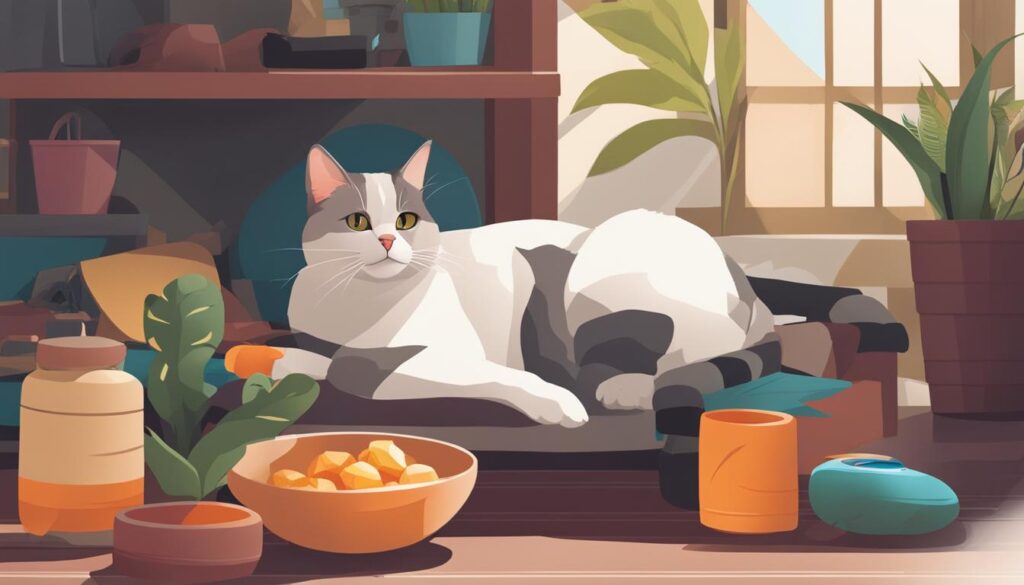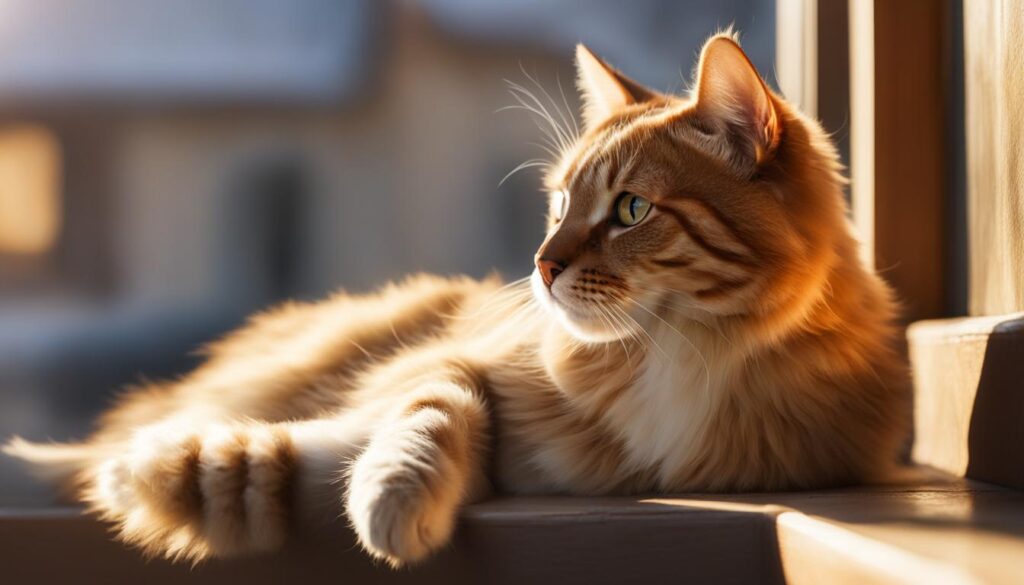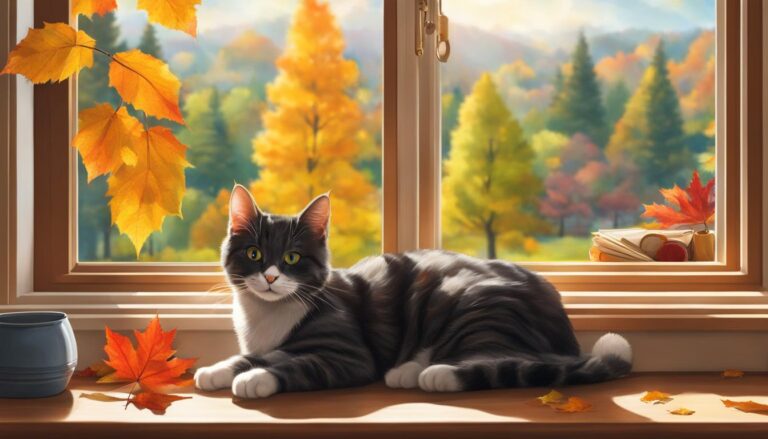Welcome to our informative guide on understanding how often cats go into heat. As a cat owner, it’s essential to be knowledgeable about your feline friend’s reproductive cycle and the signs to look out for. Cats have unique heat cycles, and understanding them will help you provide the best care and support for your pet.
Principais conclusões:
- Cats go into heat multiple times throughout their lives.
- Signs of cat heat include vocalization, affectionate behavior, and increased urination.
- The duration of a cat’s heat cycle can range from a few days to two weeks.
- Cats may go into heat as often as every 2-3 weeks.
- Spaying your cat is the best way to prevent unwanted pregnancies and health risks associated with heat cycles.
Factors Affecting the Timing of Cats Going Into Heat
The timing of when cats go into heat can be influenced by various factors. One important factor is the maturity of the cat. Most female cats begin their heat cycle around six months of age, but it can occur as early as four months for certain breeds like Siamese cats. Larger-sized cats may take longer to mature, and their heat cycles may start later than smaller breeds.
Environmental factors also play a role in the timing of cat heat cycles. Temperature and the presence of potential mates can affect when a cat goes into heat. In the Northern Hemisphere, the mating season for cats typically runs from March to September, while in the Southern Hemisphere, it’s from September to March. These natural breeding patterns can influence when a cat’s heat cycle begins and ends.
It’s important to note that indoor cats with regulated temperatures and lighting can go into heat all year round, as they are not as influenced by seasonal changes. This means that even if it’s winter outside, your indoor cat may still exhibit signs of heat. Understanding these factors can help you better anticipate and manage your cat’s heat cycles.
Table: Factors Affecting the Timing of Cats Going Into Heat
| Factors | Descrição |
|---|---|
| Cat Maturity | Most cats start their heat cycle around six months of age, but it can vary based on breed and size. |
| Environmental Factors | Temperature and the presence of potential mates can influence when a cat goes into heat. |
| Cat Mating Season | In the Northern Hemisphere, the breeding season for cats usually runs from March to September, while in the Southern Hemisphere, it’s from September to March. |
Understanding the factors that affect the timing of cats going into heat can help you better care for your feline friend. By being aware of your cat’s breed, size, and environmental conditions, you can anticipate when she is likely to enter her heat cycle. This knowledge allows you to provide the necessary support and care during this period, ensuring the well-being of your cat and preventing unwanted pregnancies.
The Estrus Cycle and Signs of Heat in Cats
The estrus cycle, also known as the heat cycle, is an important reproductive process that female cats experience throughout their lives. Understanding the signs and behaviors associated with cat heat can help you better care for your furry friend.
During the estrus cycle, cats exhibit various signs that indicate they are in heat. These signs include vocalization, affectionate behavior, rolling around on the floor, raising of the hindquarters, increased urination, attempts to escape, and possibly vaginal discharge. Some cats may also display clingy or standoffish behavior. These behaviors are natural instincts aimed at attracting potential mates.
“Cats in heat exhibit various signs, including vocalization, affectionate behavior, rolling around on the floor, raising of the hindquarters, increased urination, attempts to escape, and possibly vaginal discharge.”
It’s important to recognize these behaviors and signs of heat in order to prevent unintended pregnancies and provide appropriate care for your cat during this time. If you do not plan on breeding your cat, it is highly recommended to spay her to eliminate heat cycles and reduce the risk of health complications associated with repeated cycles, such as pyometra.
Table: Signs of Cat Heat
| Signs | Descrição |
|---|---|
| Vocalization | Cats in heat may become more vocal and make loud, attention-seeking sounds. |
| Affectionate Behavior | Cats may exhibit increased affection towards their owners, rubbing against them or demanding more attention. |
| Rolling Around | Cats may roll around on the floor more frequently, showing signs of restlessness. |
| Raising of Hindquarters | Cats in heat often raise their hindquarters, indicating their readiness to mate. |
| Increased Urination | During heat, cats tend to urinate more frequently, potentially marking their territory. |
| Escape Attempts | Cats may attempt to escape from their home in search of potential mates. |
| Vaginal Discharge | Some cats may have a noticeable discharge from their vagina during heat. |
By familiarizing yourself with the signs of cat heat, you can better understand your cat’s needs and provide the necessary support and care during this period. Remember, spaying your cat is the most effective way to prevent heat cycles and the associated behaviors and risks.
Duration and Frequency of Cat Heat Cycles
Understanding the duration and frequency of cat heat cycles is essential for every cat owner. The heat cycle, also known as the estrus cycle, can last anywhere from a few days to two weeks. During this time, your cat will display various behavioral and physical changes indicating her fertility and readiness to mate. It’s important to note that cats can go into heat as often as every 2-3 weeks, depending on their individual reproductive cycle.
Cats are seasonally polyestrus, which means they have multiple heat cycles during their breeding season. In general, the breeding season for cats occurs during warmer months and longer daylight hours. This ensures the best chances of survival for the offspring. However, it’s important to note that indoor cats, who are not influenced by external factors like temperature and daylight, can go into heat all year round.
Unlike some animals, cats do not go through menopause. This means that heat cycles can continue throughout a cat’s life, including in senior cats. It’s important to consider the health risks associated with repeated heat cycles, such as the development of pyometra, a serious infection of the uterus. Spaying your cat is the most effective way to prevent these risks and ensure her overall well-being.
| Duration of Cat Heat | Frequency of Cat Heat | Cat Breeding Season | Cat Menopause |
|---|---|---|---|
| Lasts from a few days to two weeks | Can occur as often as every 2-3 weeks | Typically during warmer months and longer daylight hours | Cats do not go through menopause |
By understanding the duration and frequency of cat heat cycles, you can better care for your cat during this time and make informed decisions about spaying to prevent health risks associated with repeated cycles.
References:
- Reference 1
- Reference 2
- Reference 3
Health Risks and Complications Related to Cat Heat
When your cat is in heat, there are certain health risks and complications that you should be aware of. One of the most serious risks is pyometra, an infection that can occur in the uterus. Pyometra causes the uterus to fill with pus and bacteria, leading to potentially life-threatening complications such as a ruptured uterus, shock, and even death.
It’s important to recognize the signs of pyometra, which include fever, vomiting, inappetence, lethargy, and pus or other drainage from the vulva. If you notice any of these symptoms in your cat, it is critical to seek immediate veterinary attention.
Pyometra can be a serious health problem for cats in heat, so it’s crucial to spay your cat to avoid the risk of this infection. Spaying is a surgical procedure that removes the ovaries and uterus, eliminating the possibility of heat cycles and the associated health complications.
By spaying your cat, you not only prevent the risk of pyometra but also reduce the chances of other health issues that can arise from repeated heat cycles. Spaying is highly recommended for cats who will not be used for breeding, as it provides a permanent solution to preventing heat cycles and ensures the overall well-being of your furry friend.
| Common Health Risks | Symptoms |
|---|---|
| Pyometra | Fever, vomiting, inappetence, lethargy, pus or other discharge from the vulva |
| Reproductive disorders | Irregular heat cycles, uterine tumors, mammary gland tumors |
| Behavioral changes | Restlessness, increased vocalization, aggression |
| Increased risk of certain diseases | Feline leukemia virus (FeLV), feline immunodeficiency virus (FIV) |
In addition to pyometra, repeated heat cycles can also increase the risk of other reproductive disorders such as irregular heat cycles, uterine tumors, and mammary gland tumors. It’s important to note that heat cycles continue in senior cats, as they do not go through menopause like some other animals.
Preventing the health risks associated with cat heat is best achieved through spaying your cat. Consult with your veterinarian to schedule the spay surgery at the appropriate age, which is typically around six months old. Spaying not only benefits your cat’s health but also helps to control the cat population and prevents the burden of unwanted kittens.
Preventing and Controlling Cat Heat Cycles
If you want to prevent your cat from going into heat and experiencing the associated behaviors and health risks, spaying is the best and safest solution. Spaying, also known as ovariohysterectomy, is a surgical procedure that removes the ovaries and uterus, eliminating heat cycles altogether. This procedure not only prevents unwanted pregnancies but also reduces the risk of pyometra, a potentially life-threatening infection of the uterus.
While there are medications available that can temporarily stop a cat’s heat cycle, they come with potential side effects and are not recommended by most veterinarians unless there is a compelling reason. These medications should only be used under veterinary supervision and when the benefits outweigh the risks. It’s important to note that these medications do not provide a permanent solution and will not prevent future heat cycles.
Spaying is a permanent and highly effective method of preventing heat cycles in cats. It is a routine procedure performed under anesthesia by a veterinarian. The recovery period is generally smooth, and your cat will be back to her normal self in no time. Spaying not only helps control heat cycles but also has many other health benefits, including reducing the risk of certain cancers and eliminating the risk of uterine infections.
Table: Spaying vs. Medications to Stop Cat Heat
| Methods | Effectiveness | Benefícios | Risks |
|---|---|---|---|
| Spaying | Highly effective; permanent solution | Prevents heat cycles, reduces the risk of pyometra, lowers the chances of certain cancers, eliminates the risk of uterine infections | Routine surgical procedure; anesthesia risks, post-operative recovery |
| Medications to Stop Cat Heat | Temporary; does not prevent future heat cycles | Can provide short-term relief from heat behaviors | Potential side effects, risks associated with uncontrolled mating |
Table summarizing the effectiveness, benefits, and risks of spaying versus using medications to stop cat heat.

Supporting Your Cat During Heat
When your cat is in heat, it’s important to provide her with the comfort and support she needs. Going through a heat cycle can be a challenging time for your feline friend, as she may experience discomfort and hormonal changes. Here are some ways you can support your cat during her heat:
- Provide a cozy and comfortable space: Set up a quiet and secluded area where your cat can relax. Consider providing a covered heated pad or a soft blanket for her to lie on. This will help alleviate any physical discomfort she may be feeling.
- Engage in playtime: Distracting your cat with playtime can help take her mind off the discomfort of being in heat. Use interactive toys, such as wand toys or puzzle feeders, to engage her mentally and physically.
- Use stress-relieving methods: Cats in heat can experience heightened stress levels. Consider using stress-relieving herbs or pheromone sprays specifically designed for cats to help ease their anxiety. These can be sprayed in the environment or on their bedding.
- Offer catnip: Catnip can have a calming effect on cats and may help reduce stress during heat. You can give your cat a small amount of catnip in a toy or sprinkle some on her bedding. However, not all cats are responsive to catnip, so observe your cat’s reaction before continuing to use it.
Remember to be patient and understanding with your cat during this time. She may exhibit unusual behaviors or mood swings due to hormonal changes, so it’s important to provide her with extra care and attention. If you have any concerns about your cat’s behavior or well-being during heat, consult with your veterinarian for further guidance and support.
Comfort and Understanding for Your Cat
Supporting your cat during her heat is crucial for her well-being. By providing a comfortable environment, engaging in playtime, using stress-relieving methods, and offering catnip, you can help alleviate her discomfort and minimize the impact of hormonal changes. Remember, every cat is unique, and what works for one may not work for another. Observe your cat’s behavior and tailor your approach to best meet her individual needs. With your love and understanding, you can help your cat navigate through this challenging time with comfort and ease.
Table 7.1: Common Signs of a Cat in Heat
| Signs of a Cat in Heat |
|---|
| Vocalization, including loud meowing and yowling |
| Increased affectionate behavior |
| Rolling around on the floor |
| Raising of the hindquarters and tail twitching |
| Increased urination |
| Attempts to escape or roam outside |
| Possible vaginal discharge |

Understanding and supporting your cat during her heat cycle is essential for her well-being. By creating a comfortable space, engaging in playtime, using stress-relieving methods, and offering catnip, you can help alleviate her discomfort and minimize the impact of hormonal changes. Remember to be patient and loving with your cat, as she may exhibit unusual behaviors during this time. Consult with your veterinarian if you have any concerns or questions about your cat’s heat cycle.
Conclusão
Understanding the frequency, signs, duration, and health risks associated with cat heat cycles is crucial for responsible cat owners like you. Female cats go into heat multiple times throughout their lives, starting as early as four months and usually around six months of age. During the heat cycle, they display various behaviors, such as vocalization, affectionate behavior, and increased urination, indicating their fertility and desire to mate.
To prevent unwanted pregnancies and health complications related to repeated heat cycles, spaying your cat is the best solution. This surgical procedure removes the ovaries and uterus, eliminating heat cycles altogether. It’s a permanent and safe method to control your cat’s reproductive cycle and ensure her overall well-being. Injectable medications to temporarily stop heat cycles are available, but they come with serious side effects and are generally not recommended by most veterinarians, unless there are exceptional circumstances.
Supporting your cat during her heat cycle is essential to alleviate any discomfort or stress she may experience. Providing a covered heated pad, engaging in playtime, and using stress-relieving herbs or pheromones can help create a comforting environment for your cat. Remember, her behavior during this time is influenced by strong hormonal changes, so patience and understanding are key.
By being informed about cat heat cycles and taking appropriate measures to prevent and control them, you are ensuring the well-being of your cat. Spaying your cat and providing support during her heat cycle are essential steps to be a responsible cat owner. So embrace your role and be the best caregiver for your feline companion!




